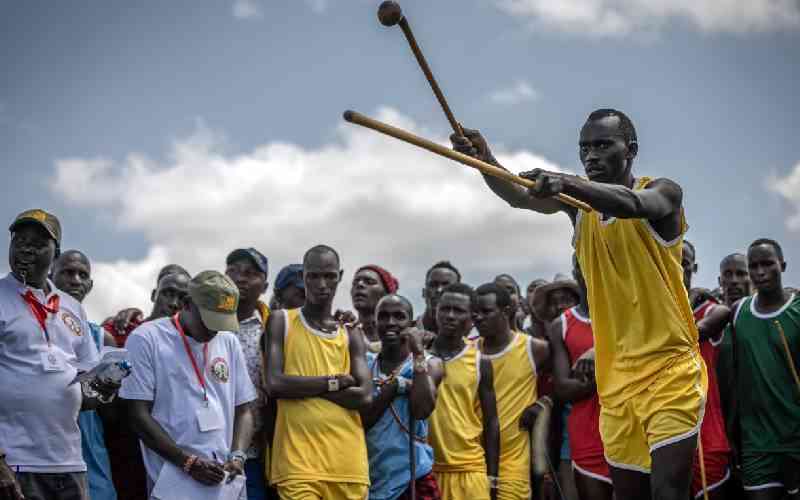By Atambo Ngoko
Marsabit, Kenya: Zawadi Leruk, 17, is a typical Rendille teenager looking forward to his initiation into an important age-set.
However, unlike other Rendille young men, Zawadi will be initiated as a Samburu moran in January 2014.
Zawadi is among a growing number of Rendille youths in Laisamis District, Marsabit County, who are becoming assimilated into the Samburu culture and language.
Zawadi was born of a Samburu mother and Rendille father, but due to the dominance of the Samburu culture in the district, he adopted his mother’s ethnicity and language, even though culturally he would have automatically assumed his father’s.
The teenager speaks the language fluently and even identifies himself as a Samburu.
“Samburu is a superior language here. Even their culture is superior. It is like Kiswahili and everybody speaks it regardless of whether he is a Samburu or Rendille,” he says.
Various groups and leaders in the area have already raised the red flag over the possibility of the Rendille culture and language becoming extinct.
One such leader is area Mandeleo Ya Wanawake Chairperson Batura Larapo, who warns that the rich Rendille culture may soon disappear if measures are not put in place to reverse the trend.
Ms Larapo says an age-set known as Limoli, which is composed of the youth aged 17 to25, has already been lost to the Samburu culture.
Endangered community
“We need to teach our children our language and culture so that it doesn’t become extinct as happened to the El Molo community,” she said.
Although the United Nations Educational, Scientific and Cultural Organisation (Unesco) does not list the Rendille as an endangered community, Lorapo says there is urgent need for action.
She also notes that the two communities (Samburu and Rendille) have different cultures that need to be protected.
There are, however, a few similarities between the two cultures that make it easy for the youth to adapt to either, although the Samburu are Nilotes while the Rendille are Cushites.
Stay informed. Subscribe to our newsletter
Both communities practice nomadic pastoralism, for instance, and have similar age-sets or groups as well as morans (community warriors).
Some members of the Rendille community also claim their youth are running away from their strict and conservative traditions to join the more liberal Samburu culture.
“It is unheard of for a Rendille girl to engage in sex before marriage, but the Samburu culture is a bit flexible on this,” says Kulamo Ikimire, a member of the Halimoitet Indigenous Association, which is one of the groups working towards the restoration of the Rendille language.
Denge Bonaya, from Kivulini Trust, claims that although 90 per cent of the population in Laisamis District is Rendille, 90 per cent of the residents speak the Samburu language.
He says only remote areas such as Korr and Kargi have pure Rendille speaking population, who also observes the culture. However, these areas are scarcely populated.
Mr Bonaya cites the high rate of intermarriage between the two communities as one of the major threats to the existence of the Rendille culture and language.
The last group speaking the Rendille in urban centres are people aged 25 years and above, says Bonaya.
Even though the 2009 census put the population of the Rendille at 60,000, Bonaya says the high rate of assimilation of the Rendille into the the Samburu culture is alarming.
The activist says there are important historical and cultural aspects of the Rendille community that need to be preserved and carried forward and this may not be possible if the integration continues.
“We have traditional shrines and holy sites for pilgrimage which have long been forgotten. In fact, no one knows when a Rendille last made the journey to the Forole sacred mountain,” says Bonaya with a lot of nostalgia.
Revive language
Kivulini Trust is partnering with various women groups to revive the diminishing use of Rendille language and are intending to kick-start the project in schools.
The group also intends to partner with the Government to develop a curriculum for vernacular studies in lower classes in order to promote the use of the language.
Raffaella Bulyaar, the chairperson of Halimetet Indigenous Association, says the group has also published books to promote the use of the Rendille language.
 The Standard Group Plc is a
multi-media organization with investments in media platforms spanning newspaper
print operations, television, radio broadcasting, digital and online services. The
Standard Group is recognized as a leading multi-media house in Kenya with a key
influence in matters of national and international interest.
The Standard Group Plc is a
multi-media organization with investments in media platforms spanning newspaper
print operations, television, radio broadcasting, digital and online services. The
Standard Group is recognized as a leading multi-media house in Kenya with a key
influence in matters of national and international interest.
 The Standard Group Plc is a
multi-media organization with investments in media platforms spanning newspaper
print operations, television, radio broadcasting, digital and online services. The
Standard Group is recognized as a leading multi-media house in Kenya with a key
influence in matters of national and international interest.
The Standard Group Plc is a
multi-media organization with investments in media platforms spanning newspaper
print operations, television, radio broadcasting, digital and online services. The
Standard Group is recognized as a leading multi-media house in Kenya with a key
influence in matters of national and international interest.









